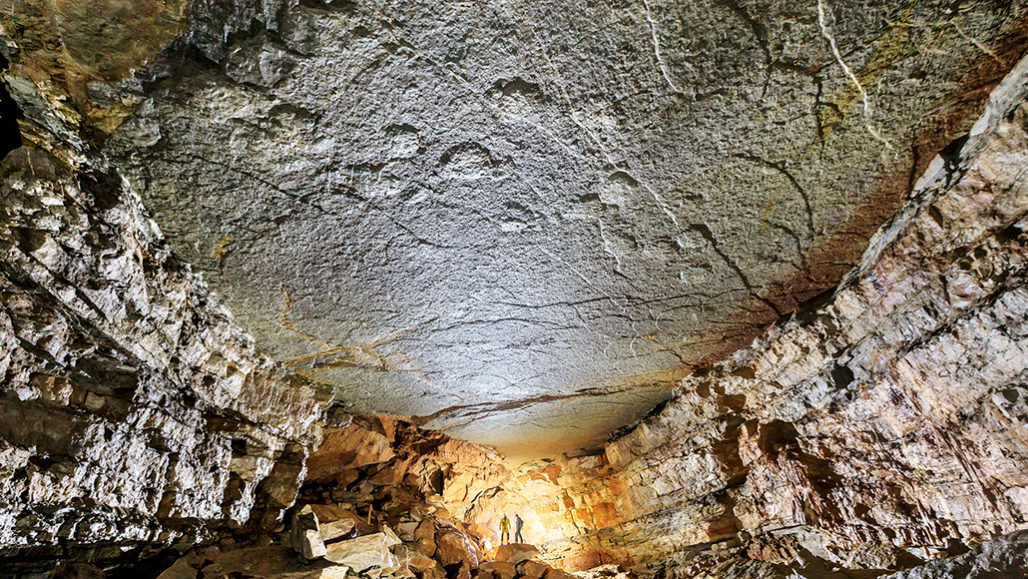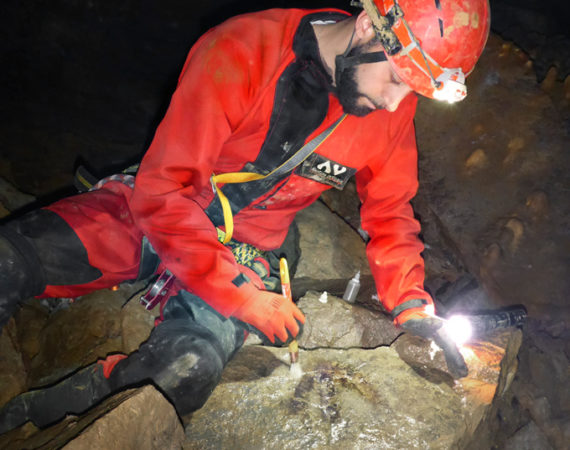The challenge of dinosaur hunting in deep caves
Paleontologists have turned up surprising dino tracks — even on the ceilings

This is France’s huge Castelbouc, where researchers and photographers have been documenting dinosaur footprints. Some are seen here as bulges on cave’s ceiling. Two team members in back offer a sense of scale.
Rémi Flament
Share this:
- Share via email (Opens in new window) Email
- Click to share on Facebook (Opens in new window) Facebook
- Click to share on X (Opens in new window) X
- Click to share on Pinterest (Opens in new window) Pinterest
- Click to share on Reddit (Opens in new window) Reddit
- Share to Google Classroom (Opens in new window) Google Classroom
- Click to print (Opens in new window) Print
Being a paleontologist can be fun. Sometimes it also can be a bit scary. Like when you’re crawling through tight underground passages in a deep, dark cave. Yet that’s what Jean-David Moreau and his colleagues have chosen to do in southern France. For them, the payoff has been rich. For instance, after descending 500 meters (a third of a mile) below the surface at one site, they discovered footprints of enormous, long-necked dinosaurs. They’re the only such sauropod footprints to ever turn up in a natural cave.
Moreau works at the Université Bourgogne Franche-Comté. It’s in Dijon, France. While at Castelbouc Cave in December 2015, his team found the sauropod prints. They had been left by behemoths related to Brachiosaurus. Such dinos could be almost 25 meters (82 feet) long. Some likely tipped the scales at nearly 80 metric tons (88 U.S. short tons).
Getting to the fossil site might make even the most hardened field scientists balk. They had to wriggle through dark, damp and cramped spaces every time they visited. That’s exhausting. It also proved hard on their elbows and knees. Carrying along delicate cameras, lights and laser scanners made it extra tricky.
Moreau also points out that it’s “not comfortable for someone claustrophobic” (afraid of tight spaces). His team spends up to 12 hours each time it ventures into these deep caves.
Such sites also can pose real danger. For instance, some parts of a cave flood now and again. So the team only enters the deep chambers during periods of drought.
Moreau has studied dinosaur footprints and plants in southern France’s Causses Basin for more than a decade. It is one of the richest areas for aboveground dinosaur tracks in Europe.
Cave explorers, known as spelunkers, first chanced upon some underground dino tracks in 2013. When Moreau and his colleagues heard about them, they realized there could be lots more hidden throughout the region’s deep, limestone caves. Footprints left in soft surface mud or sand a hundred million years ago would have turned to rock. Over the eons, these would have been forced underground.
Compared to outdoor rocks, deep caves are exposed to little wind or rain. That means they “can occasionally offer larger and better-preserved surfaces [imprinted by dinosaur steps],” Moreau observes.
His team is the only one to have discovered dino tracks in natural caverns, although others have turned up similar prints in human-made railway tunnels and mines. “The discovery of dinosaur tracks inside a natural … cave is extremely rare,” he says.

What they’ve turned up
The first subsurface dinosaur prints that the team found were 20 kilometers (12.4 miles) away from Castelbouc. This was at a site called Malaval Cave. The paleontologists reached it via an hour-long clamber through an underground river. Along the way, they encountered several 10-meter (33 foot) drops. “One of the main difficulties in the Malaval Cave is to walk taking care to not touch or break any of the delicate and unique [mineral formations],” Moreau says.
They found three-toed prints, each up to 30 centimeters (12 inches) long. These came from meat-eating dinosaurs. Some 200 million years ago, the animals left the tracks while walking upright on hind legs through a marshland. Moreau’s team described the prints in early 2018 in the International Journal of Speleology.
They also found tracks left by five-toed plant-eating dinos in Castelbouc Cave. Each footprint was up to 1.25 meters (4.1 feet) long. A trio of these enormous sauropods had been walking along the shores of some sea roughly 168 million years ago. Especially interesting are prints found on the cave’s ceiling. They are 10 meters above the floor! Moreau’s group shared what they found online March 25 in the Journal of Vertebrate Paleontology.
“The tracks we see on the roof are not ‘footprints,’” Moreau notes. “They are ‘counterprints.’” He explains that the dinos had been walking on a surface of clay. The clay beneath those prints “is nowadays totally eroded to form the cave. Here, we only see the overlying layer [of sediment that filled in the footprints].” These amount to reverse prints bulging down from the ceiling. It’s similar, he explains, to what you’d see if you filled a footprint in mud with plaster and then washed all of the mud away to leave the cast.
The tracks are important. They hail from a time in the early- to mid-Jurassic Period. This would have been 200 million to 168 million years ago. At that time, sauropods were diversifying and spreading across the world. Relatively few fossil bones from that time remain. These cave prints now confirm that sauropods had inhabited coastal or wetland environments in what is now southern France.
Moreau reports that he is now leading researchers in exploring “another deep and long cave, which has yielded hundreds of dinosaur footprints.” That team has yet to publish its results. But Moreau teases that they may prove to be the most exciting of all.







